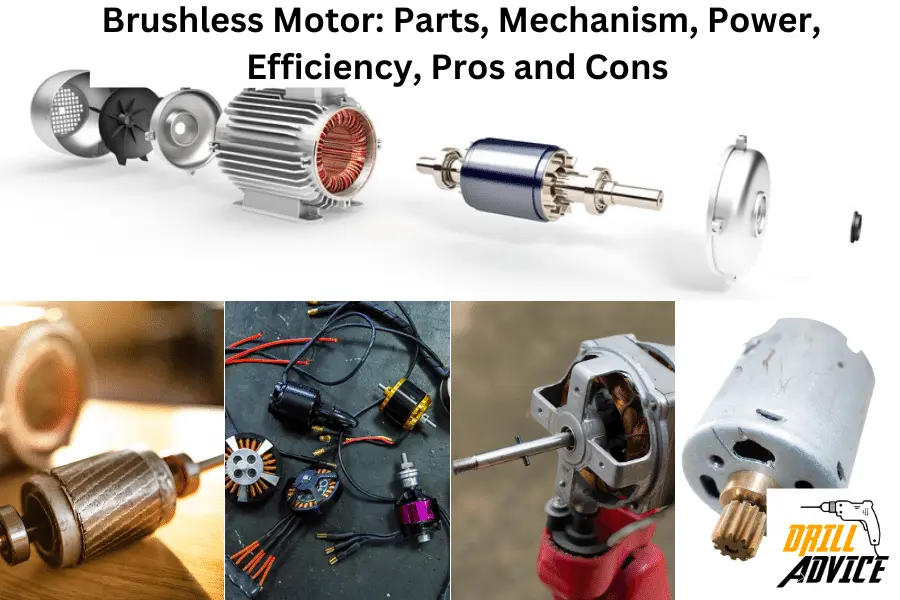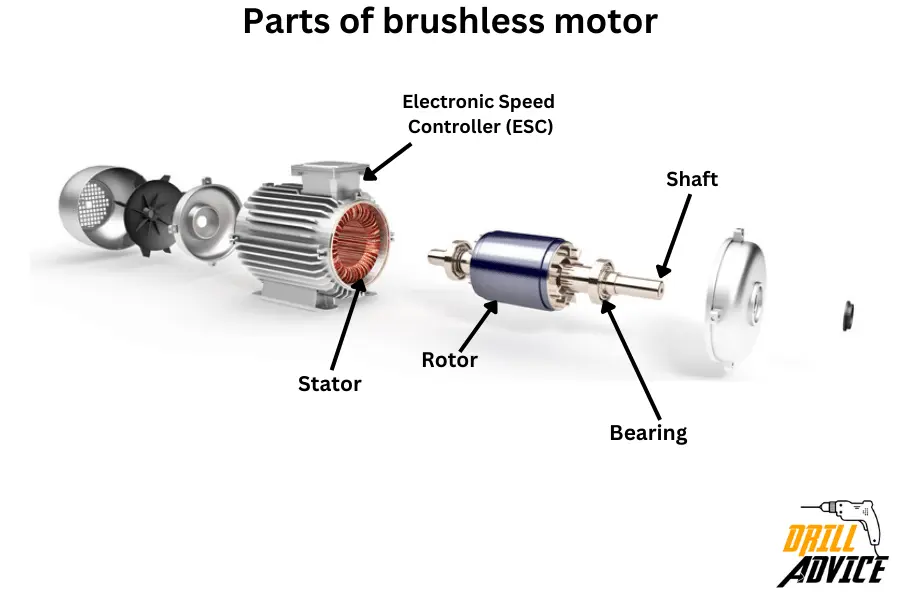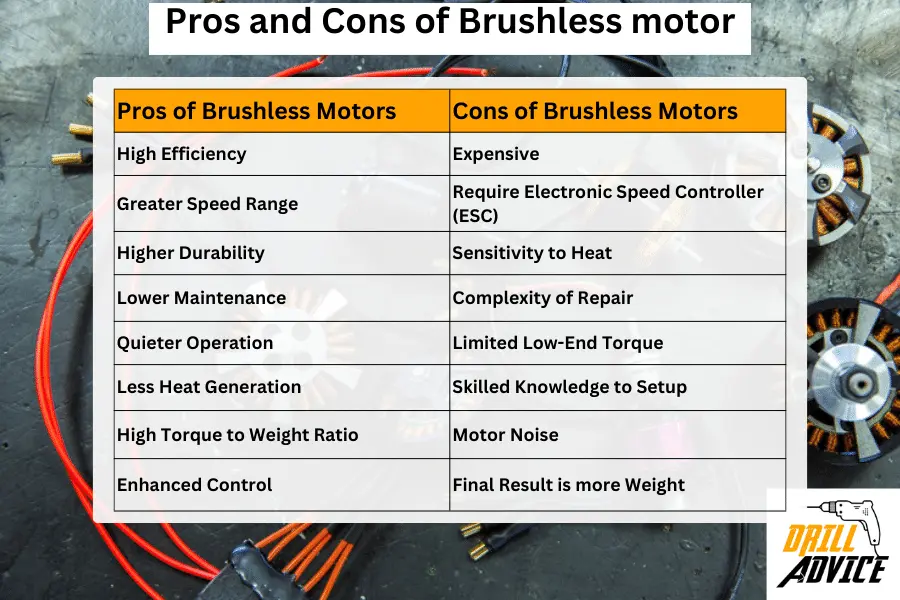
The brushless motor (BLDC) is a permanent magnet electronic motor without a carbon brush. The brushless motor can be operated with 3.7V to 24V DC voltage and 0.1A to 50A current. The main parts of the brushless motors are the stator, rotator, ESC unit, sensor, bearing, and shafts.
Brushless motors have faster rotation; therefore, it can operate at higher speeds than brushed motors without any risking damage or decreased lifespan. Each part of the brushless motor has a specific task that helps to generate the maximum output of mechanical energy from the input electronic energy. Brushless motors waste minimum energy with considering the brushed motor. Therefore brushless motors are 90% efficient.
Brushless motors are used in various modern applications. Some of those are drones, electric vehicles, power tools, computer hardware and medical instruments. Brushless motors have no carbon brushes. That is the reason for most of pros in the brushless motors.
What is a Brushless Motor?
A brushless motor (BLDC) is a permanent magnet motor that operates without the use of brushes. It is used direct current (DC) as the power supply. Brushless motors have a minimum loss of energy from heating, friction, sparking and noise. Therefore brushless motors are 90% more efficient than brushed motors.
The main parts of the brushless motor are a permanent magnet rotor, stator, sensors, and a control unit. A brushless motor operates at a typical voltage range of 3.7V to 24V, and the current can vary from 0.1A to over 50A. It is based on its application and load. Brushless motors are mostly used in these 3 modern applications such as drones, electric cars and power tools.
What are the Parts and Uses of Brushless Motors?

Brushless motors have 7 major parts. Those are the stator, rotator, ESC, sensor, bearings, housing and shaft. Stator is the permanent magnetic generation unit. Rotat is the rotating unit with shaft. ESC unit can control the electric power from the battery to the stator windings. Sensors work with the ESC. Bearings rotate the shaft smoothly. Housing will gather every part inside and the shaft will rotate with the rotator.
- Stator: The stator consists of electric coils. These coils transfer the current through the windings. These coils create a permanent magnetic field in the motor.
- Rotor: The rotas has permanent magnets. Once the stator’s coils are powered, the rotor spins in response to the magnetic field by converting electric energy into mechanical motion.
- Electronic Speed Controller (ESC): A brushless motor’s smooth operation depends on the ESC. This innovative device controls the electric power from the battery to the stator windings, orchestrating the right sequence to maintain the rotor’s spin.
- Sensors: In some brushless motors, sensors work alongside the ESC. By monitoring the rotor’s position, they provide real-time feedback, allowing for more accurate and efficient control of the motor’s operation.
- Bearings: These small parts support the rotor’s smooth rotation. Beariinngs minimize friction and wear, ensuring a longer lifespan and smoother performance of the brushless motor.
- Housing: The housing holds it all together. It provides a solid, protective structure for the stator, rotor, and other internal components, safeguarding the motor from environmental factors like dust, water, and shock.
- Shaft: The shaft is connected to the rotor, it spins as the rotor spins, transferring the motor’s mechanical energy to the device, whether it’s a fan blade, drill bit, or drone propeller.
How Does Brushless Motor Work?
The brushless motor consists of mainly 07 parts. When the motor power up below 6 steps are happening in the motor continlously.
Step 1 – Power Supply and Stator Coil Activation
When the motor is turned on, power is supplied from the DC source to the stator, which is the stationary part of the motor. The stator is arranged in a circle with multiple electromagnetic coils (the exact number will depend on the specific motor design).
Step 2 – Magnetic Field Generation
The power supply energizes these coils, which then produce magnetic fields. This magnetic field can be manipulated in terms of strength and direction by changing the current flow.
Step 3 – Rotor Movement
The rotor, which is the moving part of the motor, is embedded with permanent magnets. When the electromagnetic fields from the stator are produced, the magnetic field created attracts and repels the magnets in the rotor, causing the rotor to spin.
Step 4 – Commutation
The electronic controller or electronic speed controller (ESC) changes or commutes the electrical power to different stator windings, which continuously changes the magnetic field within the motor. The controller does this based on feedback about the rotor’s position.
Step 5 – Continuous Rotation
By continually switching which coils are activated, the motor controller can keep the rotor spinning. This process is repeated continuously for the motor to keep running.
Step 6 – Feedback Loop
The controller often uses a sensor (like a Hall effect sensor) or sensorless techniques to detect the rotor’s position. This allows the controller to know when to switch the current to the next set of coils to keep the motor running smoothly.
What is the Torque and Speed of a Brushless Motor?
Torque is the power of the motor, and the speed is the spin rate of the motor. Torque mainly depends on the current, magnet power and winding length. But the speed of the brushless motor depends on the voltage of the power source, inner friction, and temperature.
Torque
Torque is the force that causes an object to rotate around an axis. In the context of a Direct Current (DC) motor, torque is the driving force that initiates and sustains the rotation of the motor shaft. The torque determines how much load your motor can handle. Therefore, it affects the overall performance of the motor.
Speed
The speed of the motor defines how quickly the motor shaft rotates, typically measured in rotations per minute (RPM). This speed is important because it correlates directly with the motor’s output power. The faster a motor spins with a given load, the more work it can perform over time.
Brushless Motors are faster than brushed motors. Therefore brushless motors can operate at much higher speeds than Brushed Motors without risking damage or decreased lifespan.
The speed and the torque of the motor have an inversely proportional relationship. Therefore lower speed has a higher torque, and higher speed has a lower torque.
What is the Efficiency of Brushless Motor?
The efficiency, denoted by the Greek letter ‘η,’ is the ratio of mechanical power output to the electrical power input, usually expressed as a percentage. A higher efficiency implies that the motor uses less electrical energy to do the same amount of work.
The efficiency of a brushed motor is intrinsically linked to several factors such as voltage, current, friction, and heat. Voltage (V) is the force driving the electric current around the circuit. Current (I) is the rate at which electric charge flows in the circuit.
For a brushed DC motor, the efficiency can be estimated by the formula:
η = (Output Power / Input Power) x 100%.
Brushless motors do not include brushes. They use electronic controllers instead of brushes. As a result of this there is a smooth operation, less heat generation, and, consequently, a more efficient to convert electric power to mechanical power.
But brushed motors consist of commutators and brushed. When the motor is rotating, brushes produce heat, and spark from the friction with the commutator. Therefore input energy is lost due to friction, heat, and sparks. Therefore mechanical output energy is lower than brushed motors.
By considering all above facts, brushless motors are 90% more efficient than brushed motors.
Read More About – Brushless vs. Brushed Drill: Advantages, Disadvanatges
What are the Usage of Brushless Motors?
- Drones: Brushless motors are compact in size, lightweight, and high efficiency of brushless motors make them an excellent choice for drones, enabling better control and longer flight times.
- Electric Vehicles (EVs): Brushless motors in EVs contribute to superior efficiency, longer lifespans, and the capacity to handle varying speeds and loads, essential for the EV’s overall performance.
- Computer Hardware: Brushless motors are used in cooling fans for computer hardware, enhancing the device’s lifespan by reducing heat generation and increasing reliability.
- Power Tools: Cordless tools such as drills and saws use brushless motors for their higher power-to-weight ratio, offering longer battery life and more power.
- Robotics: In the field of robotics, the precise control, durability, and efficiency of brushless motors are leveraged for robotic movement and operation.
- Medical Equipment: High reliability and low noise make brushless motors well-suited for medical devices such as ventilators and diagnostic equipment.
- Home Appliances: Devices like washing machines, air conditioners, and vacuum cleaners benefit from brushless motors due to their durability and energy efficiency.
- RC Vehicles: Brushless motors in remote-controlled (RC) vehicles lead to higher speeds and better performance, due to their high power output and efficiency.
- Industrial Machinery: In industries, brushless motors are used in conveyor belts, blowers, pumps, and other machinery due to their ability to run for long periods with minimal maintenance.
- Aerospace Applications: The high power, lightweight, and efficiency of brushless motors have made them essential in aerospace technology, including in the development of electric aircraft.
What are the Pros and Cons of Brushless Motors?

The brush is the direct part to affect the pros and cons of brushless motor. The brushless motor do not have a carbon brush. Therefore it is high efficiency, faster, durable, low maintenance, low noise, higher torque-to-weigh ratio. But brushless motors are expensive, ESC requirement, heat sensitive, difficult to repair are the major cons of brushless motors.
Pros of Brushless Motors
- High Efficiency: Brushless motors boast a higher efficiency than their brushed counterparts, primarily because they lack brushes which can cause friction and heat.
- Greater Speed Range: Brushless motors are capable of operating at a wide range of speeds, providing flexibility for various applications.
- Higher Durability: The absence of brushes, which are prone to wear and tear in brushed motors, makes brushless motors more durable.
- Lower Maintenance: With no brushes to replace, brushless motors require less upkeep, saving you both time and money.
- Quieter Operation: Brushless motors tend to run quieter as there are no brushes rubbing against the commutator.
- Less Heat Generation: Less friction within the motor means less heat generation, promoting longer component life.
- High Torque to Weight Ratio: Brushless motors provide a high torque output per unit weight, making them effective for applications requiring substantial force.
- Enhanced Control: Advanced electronics allow for more precise control over brushless motor performance.
Cons of Brushless Motors
- Expensive: Brushless motors are more expensive due to their complex construction and the electronics required for operation.
- Require Electronic Speed Controller (ESC): Brushless motors necessitate the use of an ESC, adding to the overall cost and complexity.
- Sensitivity to Heat: Despite producing less heat, brushless motors are more sensitive to overheating and can be damaged if run too hot.
- Complexity of Repair: Repairing a brushless motor can be more complicated due to the advanced electronics involved.
- Limited Low-End Torque: Unlike brushed motors, brushless motors have limited low-end torque, which may not suit all applications.
- Skilled Knowledge to Setup: The setup for a brushless motor can be intricate, requiring a more in-depth understanding of electronics.
- Motor Noise: While quieter than brushed motors, brushless motors can still produce an audible whine or squeal at high speeds.
Final Result is more Weight: Brushless motors, due to their construction and the incorporated electronics, can be heavier than brushed motors.
